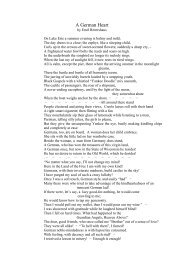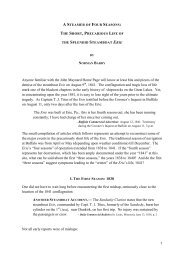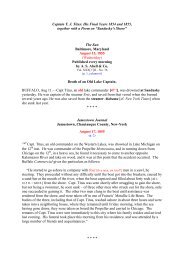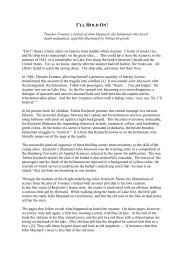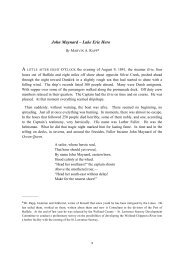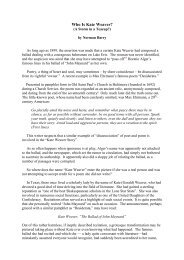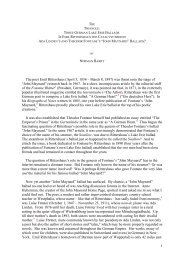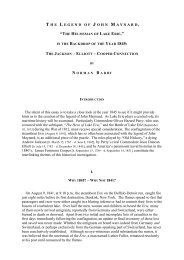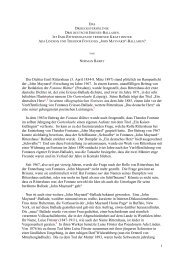The Lessons of the Lexington. - John Maynard Home Page
The Lessons of the Lexington. - John Maynard Home Page
The Lessons of the Lexington. - John Maynard Home Page
You also want an ePaper? Increase the reach of your titles
YUMPU automatically turns print PDFs into web optimized ePapers that Google loves.
<strong>The</strong>y had just begun to make use <strong>of</strong> coal for <strong>the</strong> boiler, and <strong>the</strong>re had been trouble with<br />
her blowers on her last trip from Stonington, making it necessary to lay up for repairs.<br />
<strong>The</strong> accumulation <strong>of</strong> ice, and she being one <strong>of</strong> <strong>the</strong> strongest boats <strong>of</strong> <strong>the</strong> line, it was<br />
thought best to place her on <strong>the</strong> route instead <strong>of</strong> one <strong>of</strong> <strong>the</strong> regular boats. She left New<br />
York at 4 P.M., with at least 150 persons on board and a large quantity <strong>of</strong> freight, <strong>of</strong><br />
which <strong>the</strong>re were about 150 bales <strong>of</strong> cotton. About half-past seven o’clock and when<br />
<strong>of</strong>f Eaton’s Neck, on <strong>the</strong> Long Island shore, and some four miles from land, <strong>the</strong>re was<br />
an alarm <strong>of</strong> fire, but where it first started, none <strong>of</strong> those who were saved—<strong>of</strong> which<br />
<strong>the</strong>re were but four— had any knowledge.*<br />
*A marine engineer <strong>of</strong> prominence, who was in service at this date, stated to <strong>the</strong><br />
author several years ago, that probably <strong>the</strong> want <strong>of</strong> experience in <strong>the</strong> use <strong>of</strong> <strong>the</strong> blower<br />
may have had something to do with <strong>the</strong> preliminary cause <strong>of</strong> <strong>the</strong> fire. Also, that a can<br />
<strong>of</strong> varnish in <strong>the</strong> freight was placed too close to <strong>the</strong> smoke chimney.<br />
Stephen Manchester, who was <strong>the</strong> pilot and one <strong>of</strong> <strong>the</strong> survivors, relates his<br />
experience, in part, as given in a United States document <strong>of</strong> <strong>the</strong> Twenty-sixth<br />
Congress:<br />
“I was in <strong>the</strong> wheelhouse, at <strong>the</strong> wheel, when <strong>the</strong> alarm was first given; it was<br />
about half-past seven o’clock in <strong>the</strong> evening. I was first notified <strong>of</strong> <strong>the</strong> danger<br />
by some one who came to <strong>the</strong> wheel-house door and told me that <strong>the</strong> boat was<br />
on fire—do not know who that person was. My first movement was to step out<br />
<strong>of</strong> <strong>the</strong> wheel-house and look aft. I saw <strong>the</strong> upper deck on fire all around <strong>the</strong><br />
smoke-pipe and blazing up two or three feet, perhaps, above <strong>the</strong> promenade<br />
deck. <strong>The</strong> flame seemed to be a thin sheet, and, apparently, but just<br />
commenced: <strong>the</strong> blaze seemed to follow up <strong>the</strong> smoke-pipe and was all around<br />
it. I again went into <strong>the</strong> wheel-house, caught hold <strong>of</strong> <strong>the</strong> wheel, hove it hard<br />
aport and steered <strong>the</strong> boat head to land. I thought from my first view <strong>of</strong> <strong>the</strong> fire<br />
that it was a doubtful case whe<strong>the</strong>r it could be extinguished. We were, when<br />
<strong>the</strong> fire broke out, about fifty miles from New York, <strong>of</strong>f Eaton’s Neck, and<br />
some four miles from <strong>the</strong> Long Island shore. As I<br />
p. 280: got <strong>the</strong> wheel hove hard aport, Captain Childs came into <strong>the</strong> wheelhouse,<br />
he put his hand on a spoke <strong>of</strong> <strong>the</strong> wheel and at that moment <strong>the</strong> rope<br />
gave way. At this moment <strong>the</strong> smoke came into <strong>the</strong> wheel-house so violently<br />
that we were obliged to leave it. I don’t recollect having seen Captain Childs<br />
afterwards. I called to those on <strong>the</strong> forecastle to get out <strong>the</strong> fire engine and<br />
buckets. <strong>The</strong> engine <strong>the</strong>y succeeded in getting out, but I did not see any <strong>of</strong> <strong>the</strong><br />
buckets, except two or three which we found afterward on <strong>the</strong> forecastle. I<br />
believe <strong>the</strong> ropes were not parted by <strong>the</strong> strain, but were burned <strong>of</strong>f.” After he<br />
gave his experience in helping to launch a lifeboat, and <strong>the</strong> attempts to stay <strong>the</strong><br />
progress <strong>of</strong> <strong>the</strong> flames, and <strong>the</strong> making <strong>of</strong> a raft from a spar and flagstaff with a<br />
portion <strong>of</strong> <strong>the</strong> bulwarks; also throwing overboard four baggage cars after being<br />
emptied <strong>of</strong> <strong>the</strong>ir contents, with a line attached. “Among those who remained to<br />
<strong>the</strong> last was a Mr. Van Cott, Mr. Hoyt, and Mr. Harnden, <strong>of</strong> <strong>the</strong> express: <strong>the</strong>y<br />
were all confined to <strong>the</strong> forward deck. At 12 o’clock, I left <strong>the</strong> wreck and<br />
eased myself down upon <strong>the</strong> stage or raft; from that I got on a bale <strong>of</strong> cotton,<br />
11



